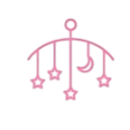Monitoring your baby’s growth is an essential part of ensuring their health and development. The baby growth chart is a vital tool used by pediatricians and parents alike to track and understand how your baby is growing over time. In this blog, we’ll delve into what a baby growth chart is, how to use it, and what it reveals about your baby’s growth and development.
1. What Is a Baby Growth Chart?
A baby growth chart is a standardized tool used to track and measure a baby’s growth over time. It includes percentile curves that illustrate the range of normal growth patterns for infants and young children. These charts are used to compare your baby’s measurements—such as weight, height, and head circumference—against those of other children of the same age and sex.
Types of Growth Charts:
- World Health Organization (WHO) Charts: Recommended for children under 2 years old, these charts are based on data from a diverse, globally representative group of children.
- Centers for Disease Control and Prevention (CDC) Charts: Often used for children aged 2 years and older in the U.S., these charts are based on data from American children.
2. Key Measurements on the Growth Chart
Weight: Tracking your baby’s weight helps ensure they are gaining weight at a healthy rate. Weight is plotted on the chart to show how it compares to the average for their age and sex.
Height/Length: Measuring your baby’s height (or length for infants) helps assess their growth pattern. Like weight, height is compared to growth percentiles on the chart.
Head Circumference: This measurement helps monitor brain growth and development. It is especially important in the early months and is plotted alongside weight and height to provide a complete picture of your baby’s growth.
3. How to Use a Growth Chart
Regular Checkups: Pediatricians will measure your baby’s weight, height, and head circumference at regular checkups and plot these measurements on the growth chart. This helps track your baby’s growth over time and identify any potential issues early on.
Interpreting Percentiles: Growth charts use percentiles to represent where your baby falls in comparison to their peers. For example, if your baby is in the 50th percentile for weight, it means they are average compared to other babies of the same age and sex. Being in a higher or lower percentile doesn’t necessarily indicate a problem, as long as your baby’s growth pattern is consistent.
Growth Trends: Instead of focusing on a single measurement, look at the overall growth trend. Consistent growth along a percentile line is generally a good sign. Sudden deviations up or down may warrant further investigation by your pediatrician.
4. Common Concerns and What They Mean
Slow Weight Gain: If your baby is consistently in a lower percentile for weight, your pediatrician may evaluate feeding practices, health conditions, or growth patterns to ensure they are growing appropriately.
Rapid Growth: Similarly, if your baby’s growth seems rapid or exceeds typical percentiles, it may be worth discussing with your pediatrician to rule out any underlying issues or conditions.
Head Circumference Variations: Variations in head circumference are normal, but significant deviations from the norm may be checked for developmental or health concerns.
5. Beyond the Numbers: Holistic Growth
Developmental Milestones: While growth charts are valuable, they are just one aspect of your baby’s overall development. Pay attention to developmental milestones, such as rolling over, sitting up, and walking, as these are also important indicators of your baby’s progress.
Health and Nutrition: Ensure your baby receives a balanced diet and regular medical checkups. Proper nutrition and health care are crucial for supporting healthy growth and development.
Emotional Well-Being: Growth charts do not measure your baby’s emotional or psychological well-being. Ensure a nurturing environment and positive interactions to support holistic development.
6. Conclusion
The baby growth chart is an essential tool for tracking your baby’s physical development and ensuring they are growing healthily. By understanding how to read and interpret growth charts, you can better support your baby’s health and development. Remember, growth charts are one part of a broader picture, and regular consultations with your pediatrician will help provide a comprehensive view of your baby’s growth and well-being.
Enjoy this special time in your baby’s life and use the growth chart as a guide to celebrate their milestones and monitor their progress. With regular checkups and a focus on overall health, you can confidently support your baby’s growth journey.



